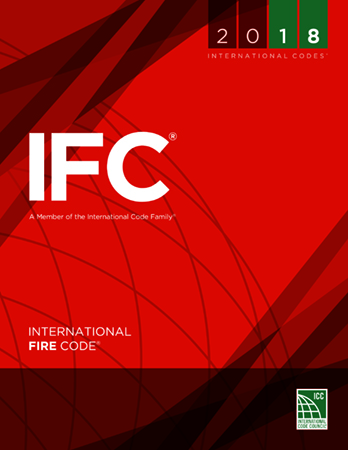
IFC
Overview of the International Fire Code® (IFC®)
Internationally, code officials recognize the need for a modern, up-to-date fire code addressing conditions hazardous to life and property from fire, explosion, handling or use of hazardous materials and the use and occupancy of buildings and premises. The International Fire Code is designed to meet these needs through model code regulations that safeguard the public health and safety in all communities, large and small.
This comprehensive fire code establishes minimum regulations for fire prevention and fire protection systems using prescriptive and performance-related provisions. It is founded on broad-based principles that make possible the use of new materials and new system designs. This 2018 edition is fully compatible with the Family of International Codes.
Benefits of the IFC:
- The provisions of this code provide protection for public health, safety and welfare from the hazards of fire, explosion or dangerous conditions in buildings, structures and premises.
- This model code is flexible in that it allows for the use of alternative and innovative materials and performance-based methods in achieving code compliance.
- This code does not give undue preferential treatment to particular types or classes of materials, products or construction methods.
- This code references nationally developed consensus standards.
- This code addresses extraordinary fire risks in existing buildings with retrospective requirements, but only in this limited area is there a need for alterations, as long as the building and its occupancies comply with reasonable fire prevention provisions.
- This code includes reasonable yet comprehensive regulations for hazardous materials.
- This code includes requirements or expanded requirements for: vacant premises, indoor displays, fire protection water supply, fire apparatus access roads, key boxes, high-piled storage, tire rebuilding and tire storage, mechanical refrigeration systems, explosion control, smoke and heat vents, lead acid battery systems.
Today's IFC is known for:
- Safety – It has a proven track record in fire prevention precautions, handling flammable liquids and other hazardous materials.
- Ease of Use – The International Fire Code uses the same easy-to-use format provided in all I-Codes.
- Embrace of New Technology - This code and its predecessors have a tradition of innovation while protecting the health and safety of the public.
- Correlation – This code is specifically correlated to work with ICC's family of codes.
- Open and Honest Code Development Process - This code is revised on a three year cycle through ICC's highly-respected consensus code development process that draws upon the expertise of hundreds of plumbing, building and safety experts from across North America.
Code Development
Current Version: 2018 IFC
- Purchase the newest edition of the code and references.
Upcoming Version: 2021 IFC Development
The International Fire Code provisions provide many benefits, among which is the model code development process that offers an international forum for fire safety professionals to discuss performance and prescriptive code requirements. This forum provides an excellent arena to debate proposed revisions. This model code also encourages international consistency in the application of provisions.
- Get the 2021 code development schedule.
- Learn more about ICC's web-based code development process, cdpACCESS.
Adoptions of the IFC
The International Fire Code (IFC) is in use or adopted in 42 states, the District of Columbia, New York City, Guam and Puerto Rico.
As a model code, the IFC is intended to be adopted in accordance with the laws and procedures of a governmental jurisdiction. When adopting a model code like the IFC, some jurisdictions amend the code in the process to reflect local practices and laws.

